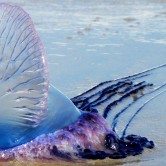
Portuguese Man O’War, known for their potentially lethal sting, have recently been spotted washed up on beaches throughout the UK. These deadly jellyfish were initially found in Ireland; however, in recent days and weeks they have started to turn up on beaches in Cornwall, the Scilly Isles and Dorset.
It is not that common to find Portuguese man o’war jellyfish around our waters, although they can turn up if they get blown in from the Atlantic – usually around this time of year. When they do make an appearance, however, they can often show up in large numbers. The last significant sightings of these jellyfish around the UK were in 2009 and 2012.
Marine Conservation Society Urges Caution
The Marine Conservation Society is advising beachgoers to be especially cautious, particularly in the regions where these creatures have already been recently spotted, in addition to locations nearby. If anyone notices one of these jellyfish, they are advised not to touch it and to report it immediately.
The Portuguese man o’war jellyfish can be found floating in the water or stranded on the beach after the tide has gone out. They often resemble a deflated purple balloon with blue ribbons attached, something that can make them very attractive to the attention of children. The blue ribbons are the tentacles of the jellyfish and can be several metres long. The Portuguese man o’war is not one single jellyfish; in fact, it is only a close relative of the jellyfish. It comprises minute organisms that form together to make one creature.
Be on alert especially if you have children accompanying you to a beach where the jellyfish have been spotted; their colourful deflated balloon appearance is sure to entice them over for further inspection. Stay on guard and keep an eye on the tide times in case any have been washed up by the incoming waters.
